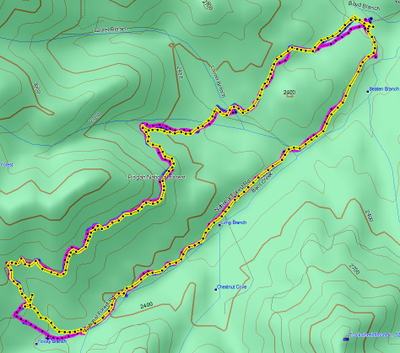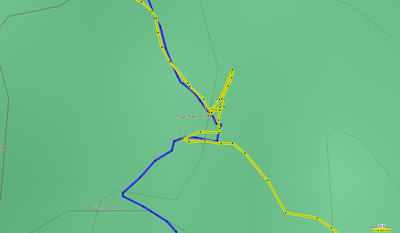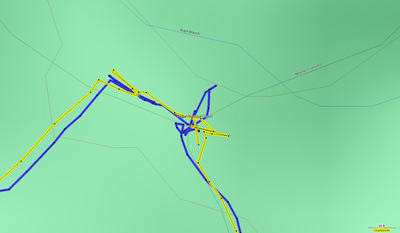
I’ve been spending some time on the trail with my Garmin Colorado 300 and have been testing it against the Garmin 60CSx. Some folks have asked questions about satellite reception, since the Colorado reportedly uses a proprietary chipset and not the SiRFstar III found in the 60CSx. The image above compares tracklogs from both for the same mountain bike ride. Topography was steep in places, with canopy varying from deciduous trees to some mixed evergreens. Not the most difficult conditions but challenging enough that older receivers would likely have dropped out numerous times.
The yellow is the Colorado 300; the blue is the 60CSx. Notice that the tracks separate in the SW corner. I had a previous track of the same ride collected with the 60CSx, and that one is layered on in what Garmin calls magenta (i.e., pink) below.

It appears from this that the 60CSx was more accurate, but notice that the older 60CSx track veers away from the other two in the NE corner, so I wouldn’t draw too quick of a conclusion. The two images above can be clicked for a more detailed view, BTW.
Digging a little deeper, we see that the Colorado did more wandering at a point where I got off the bike for a snack, as shown below in this detail near the SW corner.

Both devices’ tracklogs wandered around the trailhead near the NE corner of the ride.

One other interesting thing. Both devices were on my handlebars at the start of the ride. Midway through though (shortly after the SW snack I believe), I gave up on the Colorado mount and put it in the outside mesh pocket of my CamelBak. This may have been a slightly more challenging position for reception than being on the handlebars.
Conclusion
I’m not sure you can draw a definitive conclusion from this, but I feel like I’m only going out on a limb a little to say that these are both excellent devices and that you will likely see very little difference in reception performance between them.

Rich,
Thanks for the comparison, since I only have a 60cs it is hard for me to compare to the 60csx. In general I’ve been very happy with the CO reception. Two things I’ve noticed and I’d like to see if you or others have seen:
1) Let the unit sit off for 10-12 hours overnight, move 15-20 miles from the last location it was turned on and try to get lock when you are moving in a car. Several times I’ve seen this take more than 10 minutes. I haven’t tested with the latest software but I’m wondering if this is a challenging situation for the receiver — I seem to remember similar issues with the 60csx when it came out.
2) I’ve noticed on 8-10 different occasions, some with 2.4/2.6 software, a large position error (relative to prior tracks/waypoints). What I observe is this: EPE grows to 60-90′, the position error is really more like 100-200′ and the Colorado can’t seem to get out of this state. If I stop moving for several minutes nothing improves. If I power cycle the unit while stationary the EPE jumps back down to 20-30′ after relock, with the same satellites and my location is back to where it should be.
I have not idea what triggers this condition but every time this has happened (I watch GPS accuracy on the map page all the time now) if I simply stop and power cycle the problem goes away. Certainly feels like a software problem to me.
GO$Rs
GO$Rs,
I haven’t seen either. I’ll have to check out number one sometime.
Thanks for your participation here BTW. I appreciate all that you are adding to the discussion.
I’ve done some similar testing. Units of the *same* model gathering data in the same place will sometime show observable deviations in tracks, too.
It’s important to remember that every GPS reports position with a degree of confidence within a “cloud”. Sometimes unit A will ride one edge of the cloud for several fixes in a row and unit B will ride the other edge. The result in the track is a split.
Also, did you have both units set to the same sampling modes? Probably 1/sec would be “best” for a test like this; the resulting GPX will be large. The default of ‘auto’ mangles the details of track logs.
Ah Robert. Not much gets by you. Guilty as charged — both were set to auto. Oh well, guess that gives me an excuse to get back out on the bike!
Garmin 60CSx units rock!